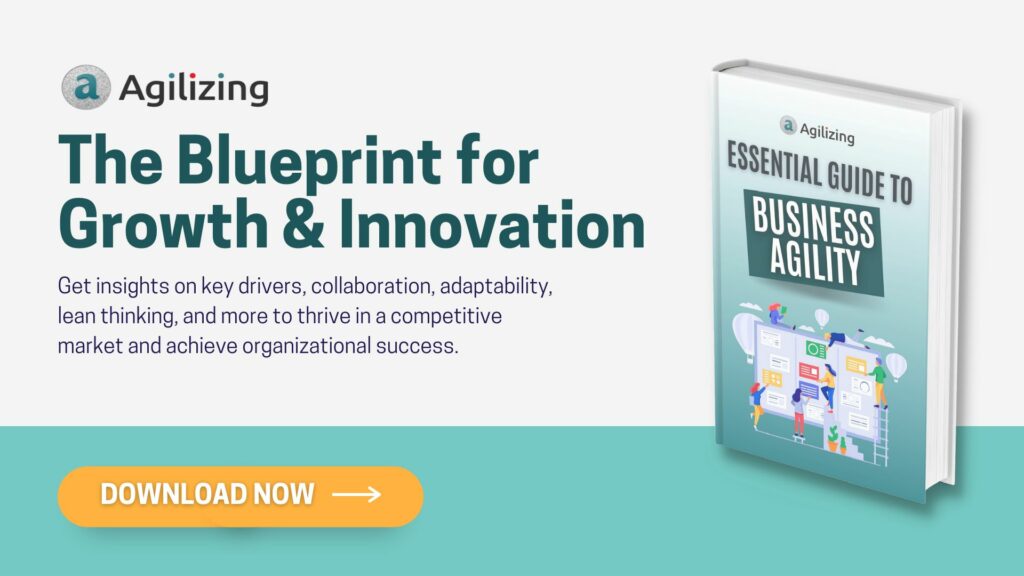Strength Development Inventory 2.0
SDI 2.0 (Strength Deployment Inventory) is a tool used to assess an individual’s strengths and their ability to interact with others. This assessment measures an individual’s primary motives, their behavior in conflict situations, their strengths, and the potential limitations of their strengths in interpersonal relationships. By providing a personalized understanding of these four aspects, the SDI 2.0 offers Relationship Intelligence (RQ) to aid individuals and teams in developing trustworthy and productive relationships.
The assessment results provide a personalized Strengths Portrait that ranks an individual’s strengths and shows how they prioritize these behaviors in their daily work relationships. Additionally, the assessment results show the strengths an individual is most likely to overdo and how to adjust their behavior to avoid negative reactions. The SDI 2.0 can be used to improve communication, build trust, and foster collaboration within teams.
Because the assessment measures four unique views, your SDI 2.0 results are more than a snapshot, they’re a map. Your results are nuanced and personalized to who you are, how you can be the best version of yourself, and how you can make choices that strengthen your connection with the people around you.
Motivational Value System
Your approach to life is influenced by three main motives: People, Performance, and Process. Some individuals prioritize supporting others and being helpful, while others are more results-oriented, striving to accomplish tasks better and faster than their peers. Still, others prioritize following the correct procedures and achieving objectives accurately. Many individuals have an equal balance of these three motives.
Using your scores, the SDI 2.0 generates a dot that represents your blend of these motives and places it on the SDI Triangle, which is divided into seven regions. These regions are color-coded to show which of the three core motives – People, Performance, or Process – you prioritize the most. This system is known as your Motivational Value System (MVS), and your MVS dot demonstrates what is most essential to you when everything is going well.
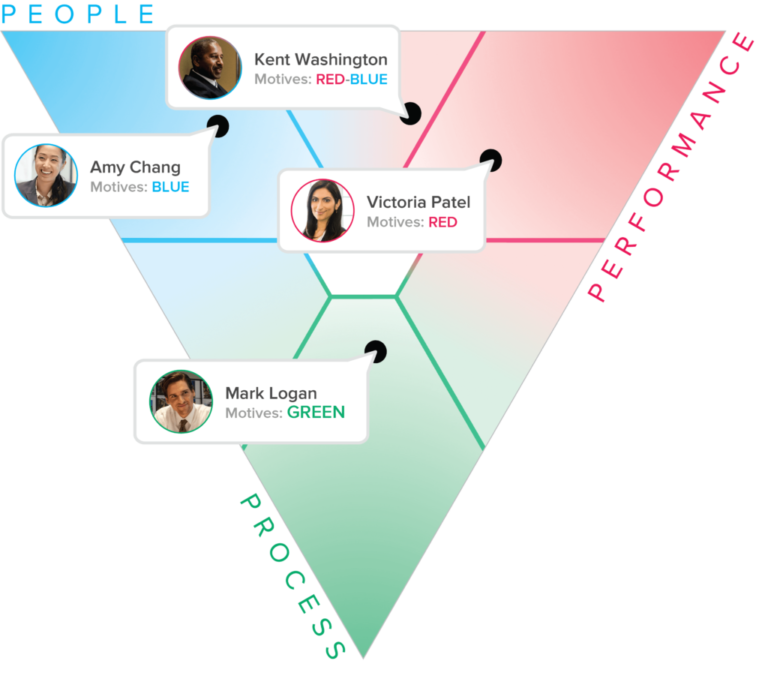
The SDI shows your blend of motives as a dot on the Triangle.
Conflict Sequence
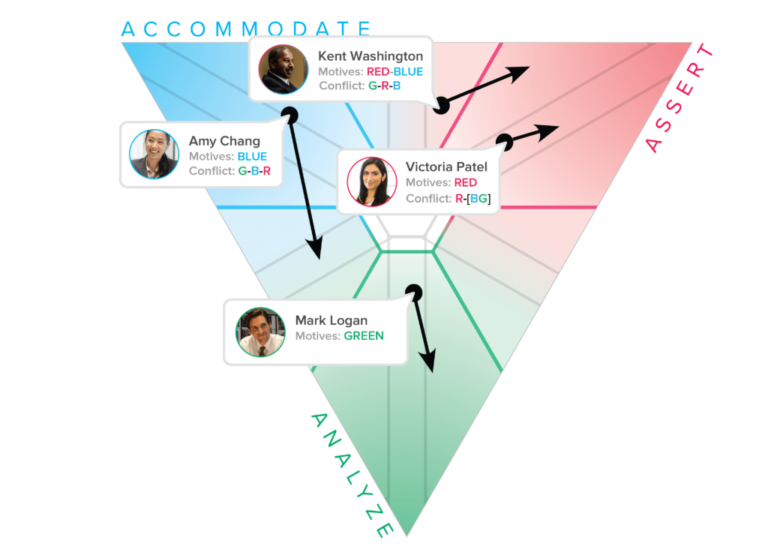
The SDI Triangle shows how your motives change in conflict.
Relationships may encounter conflict, which occurs when an individual’s values and motives are threatened. During such situations, individuals often feel uneasy and may not perform at their best. The Conflict Sequence, which identifies the predictable changes in an individual’s motives during a conflict, is divided into three stages: Accommodate, Assert, and Analyze. Everyone goes through these stages in different orders, and the Conflict Sequence is shown on the SDI Triangle with an arrowhead in one of thirteen regions.
Motives and conflict are interrelated, as individuals are more likely to experience conflict over things that are significant to them. However, the SDI 2.0 provides individuals with the tools to manage and resolve conflict effectively, regardless of its intensity. In summary, the SDI 2.0 tool represents an individual’s motives on a color-coded triangle using a dot, while the Conflict Sequence is represented by an arrowhead that demonstrates the predictable changes in an individual’s motives during the three stages of conflict.
Strengths Portrait
The Strengths Portrait, which is derived from your assessment results, provides a narrative of how you utilize your strengths when interacting with others. The strengths measured in the assessment are not skills or competencies, but rather the behaviors you employ when attempting to accomplish a goal.
Your Strengths Portrait ranks your strengths from 1 to 28, revealing how you prioritize these behaviors in your daily work relationships. Some strengths are energizing, while others are not. The strengths at the top of the list are the most similar to you, and you use them most often. The middle strengths are utilized less frequently, and you may be hesitant to use the strengths at the bottom or avoid them altogether. While your top strengths are often highly effective, they may not always work in all situations or with all individuals. Nevertheless, you have the option to use different strengths as needed.
To determine if you are using the appropriate strengths, observe your interactions with others. Are your strengths producing the desired outcomes and reactions? Are you accomplishing your objectives while simultaneously improving the situation for others? Choosing the appropriate strengths promotes collaboration and strengthens bonds within your team.

Example Strengths Portrait
Overdone Strengths Portrait
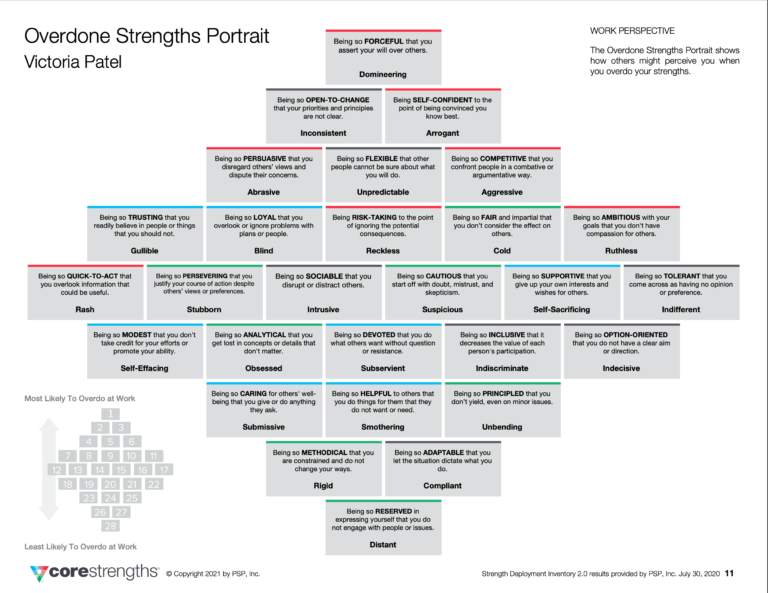
Example Overdone Strengths Portrait
The common perception of weaknesses as flaws or areas of incompetence is not entirely accurate. In reality, weaknesses are strengths that are overdone, meaning that they are taken to an extreme that can lead to negative outcomes. Just like good music that is played too loudly, overdone strengths can cause unintended reactions and make others perceive them as weaknesses.
Assessment results can identify the strengths that you are most likely to overdo, how others might perceive you because of them, and how you might misjudge others. The overdone strengths at the bottom of your portrait should never be overdone because they can trigger conflicts. It is important to keep in mind that others are not trying to overdo their strengths, and it is best to find their positive intent rather than judging them. When your own strengths are not working well, try to bring in a different strength that is better suited to the situation. You can reduce the frequency, duration, or intensity of an overdone strength to turn it back into a productive strength.
What Make SDI Unique?
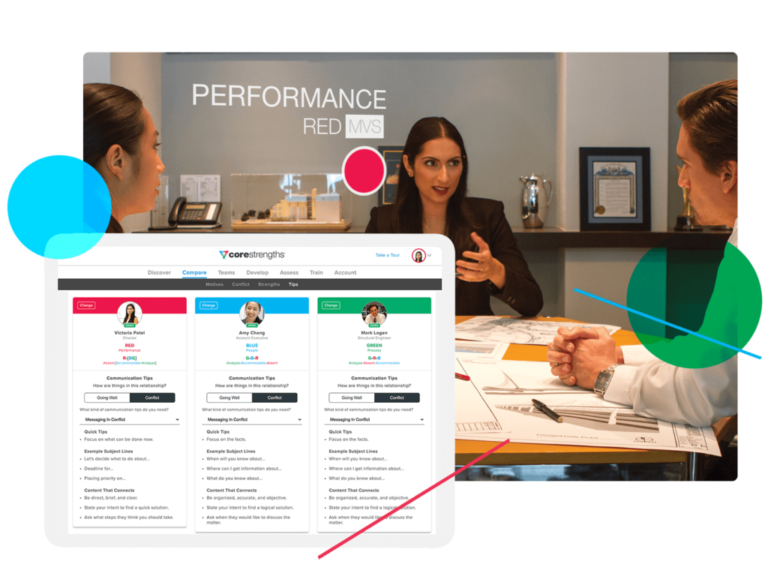
What if you had instant access into everyone’s communication style?
The Core Strengths Platform reinforces Relationship Intelligence (RQ) across your entire network. And as more people take the SDI 2.0, others can access their results, allowing the frame of reference for navigating personality differences to spread throughout the organization.
This focused effort on strengthening working relationships pays off quickly with better individual and group results.
With the platform you will:
- Get or review personalized SDI 2.0 assessment debriefs.
- Compare profiles with coworkers and teams for fresh insight on how to approach conversations, presentations, and performance reviews.
- Access customized, real-time coaching on how to craft messages, prep for meetings, or enter high-stakes conversations.
Based on a solid scientific foundation - Research based on 5,000,000 assessments!
Contact Us
To learn more about Strength Development Inventory or to discuss your specific needs, please contact us today. Our team of experts is ready to help you achieve your goals and experience the Strength Deployment Inventory (SDI 2.0) for yourself and master Relationship Intelligence.


